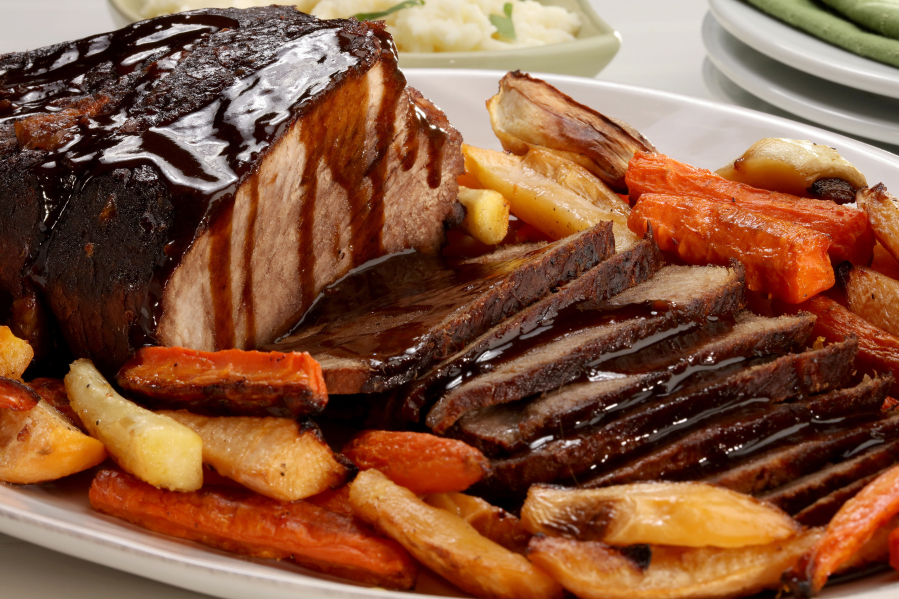The more devoted PrepSchoobeeDoBees among you may recall we first broached the topic of braising about 10 years back. Today, a little refresher. Heed its lessons, and practice its tenets, and soon you’ll be thinking, “Well, who knows what fresh hell the future may bring, but, sweet mother of pearl, at least I can braise a piece of meat.”
WHY YOU NEED TO LEARN THIS
The braising method is designed to take tough (read “cheap”) cuts of meat and render them moist and tender. Plus, the rich velvety sauce that is its natural byproduct will make you glad our ancestors evolved tongues.
THE STEPS YOU TAKE
In a nutshell, braising combines a quick sear of a large hunk of meat with a longer, slow simmering in a flavorful liquid.
Conveniently, cooking follows the laws of the universe, just like everything else in the universe, no matter what the science-averse like loudly and confoundingly to aver. This means that everything that happens in the kitchen happens because it has to happen, given what you’ve done to the food. Dig?
The more you know about the composition of your food, and the more you understand how the forces of nature (heat!) affect that composition, the more likely your actual outcomes will align with your desired outcomes.
Meat comes from muscle, and the more exercise a muscle gets, the tougher its meat will be. This has to do largely (though not completely) with tough connective tissue. To wit:
Imagine you’re a dauntless international smuggler, outfoxing corrupt local authorities while ferrying much-needed antibiotics and bootleg copies of “Frampton Comes Alive” across international boundaries. Imagine, too, that your day off finds you on a Caribbean afternoon, stretched on the sun-warmed wing of your vintage Cessna 172 Skyhawk. As the afternoon progresses, you roll from side to side, your head nestled comfortably on the folded layers of your white satin flight scarf. There’s no fear of tumbling from the wing because the plane lies motionless on the tarmac.
Suddenly, your archnemesis leaps into the cockpit, grabs the stick and begins piloting your plane down the runway. You grab your scarf and lash your wrist to a nearby wing strut. As the plane noses into the air, you realize the old “lash-the-wrist-to-the-strut” trick may not prevent you from plummeting to a pancake-y end. You wrap the scarf repeatedly around your arm, the strut, your legs and your waist until you are fastened tightly to the plane. No matter what death-defying feat of aero-acrobatics the dastardly villain attempts, you are assured of survival, due to the strength of those bonds.
That’s how meat works. Muscles that get a lot of exercise must be more securely tethered with a connective tissue called “collagen.”
In the kitchen, we love collagen. When heated slowly, it breaks down into gelatin and water. In a braise, that gelatin gives the braising liquid body and mouthfeel. The longer the braise, the lovelier that mouthfeel and the more tender the meat, since there’s less collagen holding it together. You know the phrase, “falling-off-the-bone tender”? This is where it comes from.
Braising is not for every cut of meat. There’s no reason to braise a chicken breast or a pork tenderloin because they’re already tender. Tougher cuts, though, benefit greatly from a braise.
And the thing is, once you understand the method, you can braise anything that needs it: a beef brisket, a veal shank, anything.
HOW TO BRAISE
1. Put a heavy bottomed stockpot over medium high heat. When the pan is hot, add just enough oil to coat the bottom. Sear your seasoned meat on all sides until brown, 1 to 2 minutes per side. Remove and set aside.
2. Add aromatic vegetables, like mirepoix (a 2-to-1-to-1 mix of onions, carrots and celery – it should be roughly 20 percent of the weight of your meat). Saute until lightly browned, then deglaze.
3. Return the meat to the pot with enough liquid – beer, wine, stock, water – to come halfway up the sides of the meat. Add any other flavoring ingredients. Bring to a boil, then cover and simmer over low heat on the stove-top or in a 325-degree oven until the meat is falling apart. This can be anywhere from one to several hours, depending on the size and cut of the meat.
4. Adjust the seasoning of the braising liquid, and serve immediately with the meat.
Or: Remove the meat. Strain the liquid into a clean saucepan, discarding the spent vegetable. Reduce the liquid until it coats the back of a spoon, or thicken it with beurre manie (equal parts butter and flour mashed into a paste) or a slurry of cornstarch or flour dissolved in cold liquid. Return the meat to the sauce along with any additional vegetables and serve immediately.
Herewith, some ideas for deliciously painless braises:
1. Think Italian, and braise pork shoulder in your favorite simple tomato sauce. To serve, augment the sauce with sauteed mushrooms, onions and peppers.
2. Do a variation of the Belgian stew called carbonnade, and caramelize some julienned onions in your stockpot before braising a beef chuck roast in a Belgian ale. Or turn it Irish with some Guinness Extra Stout.
3. Go French with coq au vin: Braise an 8-cut chicken in red wine, then augment the strained, thickened sauce with precooked pearl onions, mushrooms and bacon.



